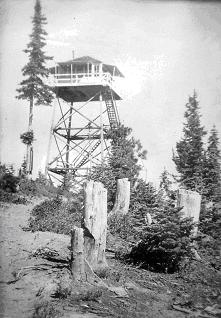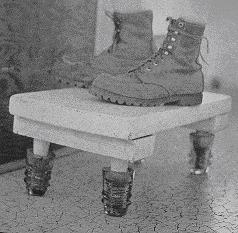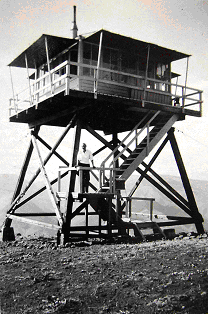|
James D. Currie Fairborn, OH Copperas Cove, TX QCWA # 25929 |
 |
Jim grew up in the small community of Peshastin close to Wenatchee in the central part of the state of Washington. He was the only child of a rancher couple. He was only 12 years old when his mother died at age of 42. Soon after, his dad also passed away, and thereafter, young Jim was raised by loving foster parents. His exposure to two factors influenced how his life played out. One was the surrounding wilderness; the woods and mountains made him familiar with nature and curious of its hidden qualities. The other factor was that his town had a large number of Mexican immigrants and their peculiar language attracted him, as all children like the mysterious. And, of course, it is now known that kids learn foreign languages with great ease, especially between the ages of three and seven.
Right out of school at the tender age of 16, Jim was lucky to find a job with the National Forest Service to man a fire tower, a position he held between the years of 1945 to 1950. Early detection of fires was a top priority of the Forest Service in order to activate fire crews quickly to extinguish fires before they got out of control. Sadly this approach was abandoned such that out of the 60 towers left in 1950, there are only four towers remaining, and these benefit logging crews. Perhaps the devastating and costly fires we experience frequently today should have us reevaluate our present approach.
Jim describes the fire towers, located atop of hills as follows: They were built from local timber; four legs supported a small roofed open platform. The height of the tower was such that a clear 360-degree view was obtained. This meant most towers were about 50 feet tall but there were some taller ones and some lower ones. The entire structure was wired for lightning protection like a faraday cage with copper wires as thick as your little finger. There were lightning rods on all four corners of the roof of the observation platform. Jim brought binoculars (7x50), but the service required observation without glasses relying on the good vision of young observers. Maps to locate and mark trouble points and a radio to report fires and communicate were the only tools.
The radio, weighing about 20 pounds, allowed voice contact with headquarters and with other observation towers in the region. CW was also used for relaying weather data that were coded in numbers. Speed was slow, about 10 wpm. The vertical antenna was "under foot" on the side of the tower, so to be safe from lightning. The observer stayed on the tower during thunderstorms to observe the lightning. From his description I gathered that the proper precautions were taken, and he couldn't remember a single bad lightning incident. The method standing on this little stool with the glass insulators on the bottom should work theoretically, but it had few followers. See photo: It might be compared to being inside a (metallic) car where the car itself is isolated from the ground by the rubber tires.
They were prohibited from investigating the radio and no schematic was supplied. But Jim's curiosity got the better of him and he opened up the radio to look inside. He found two tubes and a fairly simple circuit. In those days circuits were built that way and hams, for instance, lived with the circuits in their heads. Today you would be lost without a schematic.
Anyhow, it made Jim confident enough to get involved with electronics, to study ham radio and to pass the exam after his second summer on the lookout point (1947). As for the frequency, he remembers that the antenna was 16 feet long and was fed by a short piece of coax. Presumably, this was roughly a quarter wavelength that would indicate a frequency in the vicinity of the 20m band.
Jim relates one smoke detection story that turned out to be a false alarm: On a sunny afternoon he observed a whiff of smoke from a certain direction and a short time afterwards another report came in placing the smoke in the same general area except that it was a mile away. Headquarters got agitated and demanded more accurate readings. But basically the distance between the fires remained about a mile. The puzzle solved: A steam engine had passed through the area and there was a one-mile tunnel that it had gone through!
Some of the lookouts were quite isolated, as many as eight miles away to the next road. Observation was during daytime hours. There was a small cottage (12'x12' with a 4'x4' fireplace in the center) at the foot of the tower with the bare necessities for a single person and the towers were occupied from late March to early November. Jim didn't mind being alone, in fact he felt a part of nature and was at peace with himself and the world. Through the radio he stayed in touch with all the other lookouts, there were about six or seven, he remembers. At one of them was a young lady. He took a liking to Barbara and eventually met her in person.
With the outbreak of the Korean War, Jim was drafted into the Army and into basic training in preparation for deployment. That's when Barbara and Jim tied the knots. War is terrible. In particular this one is known as the forgotten war. Recently, a documentary on Public TV, "Hold at all Costs", about the infamous "Out Post (OP) Harry" during the summer of 1953, presents a dramatic, unnerving sketch. It was just plain terrible. Jim's time in Korea preceded this event and was horrific as well; he doesn't like to talk about it. However, he has a dream to travel to China and to meet with a surviving soldier from the other side.
After returning from the war Jim went to college, the positive effect of the GI-bill. With great ambition he took courses in biology, chemistry and mathematics.
With a first class radio license he had gotten while in the Army, Jim landed a job at the Bemidji Radio station KBUN in Minnesota, where he remained for 2 1/2 years. From there he went to Washington to work for the CIA. After 3 years in DC (1956) he applied for a job at the newly established ATIC "Air Technical Intelligence Center", later to become the FTD "Foreign Technology Division", located at WPAFB "Wright Patterson Air Force Base" just north of Dayton. This new organization was keeping tabs on what other countries were exploring, a challenging and highly exciting task. Jim stayed with this organization until retirement in 1984.
Most hams have hobbies besides Ham Radio. Jim's lifelong love of nature led him to astronomy and telescopes. He actually built several, grinding his own mirrors. He is still quite interested in this second hobby, observing with great interest sunspots with a white light telescope.
His family suffered a major loss with the passing of his wife Barbara in 1990. Jim and Barbara had two sons and a daughter, but no grandchildren.
He was and is still active in Ham Radio, now mostly on 75m and in various nets. He also gets on 2m about once a week. In earlier days he tried DX and found he could only get so far with a hundred watts or so. Of course, he is proud of the dx he worked with his limited power. The ease with which the kW-stations would work dx irritated him but more so the 59s they exchanged in the contests. One time, he relates, receiving a 5-0 report, which is definitely possible, but it is usually formulated like "you are not moving my s-meter."
So his activity was with nets and emergency traffic. For many years he conducted the local Chapter 9 net on 3.975 MHz.
Jim advises youngsters to engage in Ham Radio or for that matter in any interesting subject and apply themselves fully. This is both useful and satisfying for the person and his intellectual development.
 Estes Butte Look Out Jim's location |
 The lightning protection Stool It might just work! |
 Badger Mtn Look Out Barbara's location |
December 31, 2011